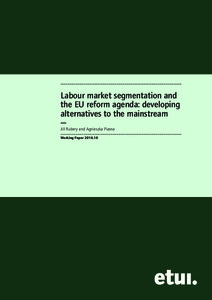Labour market segmentation and the EU reform agenda: developing alternatives to the mainstream
"European employment regulation has been repeatedly identified by policymakers as too stringent resulting in policy recommendations aimed at a more flexible labour market. This diagnosis has been reaffirmed, particularly by international policymakers, in the post-2008 economic and jobs crisis w...
| Main Authors: | , |
|---|---|
| Institution: | ETUI-European Trade Union Institute |
| Format: | TEXT |
| Language: | English |
| Published: |
Brussels
2016
ETUI |
| Subjects: | |
| Online Access: | https://www.labourline.org/KENTIKA-032512485079-Labour-market-segmentation-and.htm |
| Summary: | "European employment regulation has been repeatedly identified by policymakers as too stringent resulting in policy recommendations aimed at a more flexible labour market. This diagnosis has been reaffirmed, particularly by international policymakers, in the post-2008 economic and jobs crisis with high employment protection regarded as harmful for employment, responsible for boosting precarious jobs and likely to result in social costs including unemployment. The labour market reforms pushed by the European Commission after 2010 targeted reducing employment protection legislation (EPL) with the dual expectation that they will revive “job creation in sclerotic labour markets while tackling segmentation and adjustment at the same time” (European Commission 2012, 4).
In this paper the authors argue that the current—overwhelmingly deregulatory—reform agenda is too narrowly specified. Above all, the debate needs to be turned around from the focus on de-regulation to the role of re-regulation for inclusive labour markets. With the focus on costs-related disincentives for employers to use standard forms of employment, the dominant debate fails to recognise a more complex set of problems that may put groups of workers at risk of exclusion." |
|---|---|
| Physical Description: | 30 p. Paper Digital |

